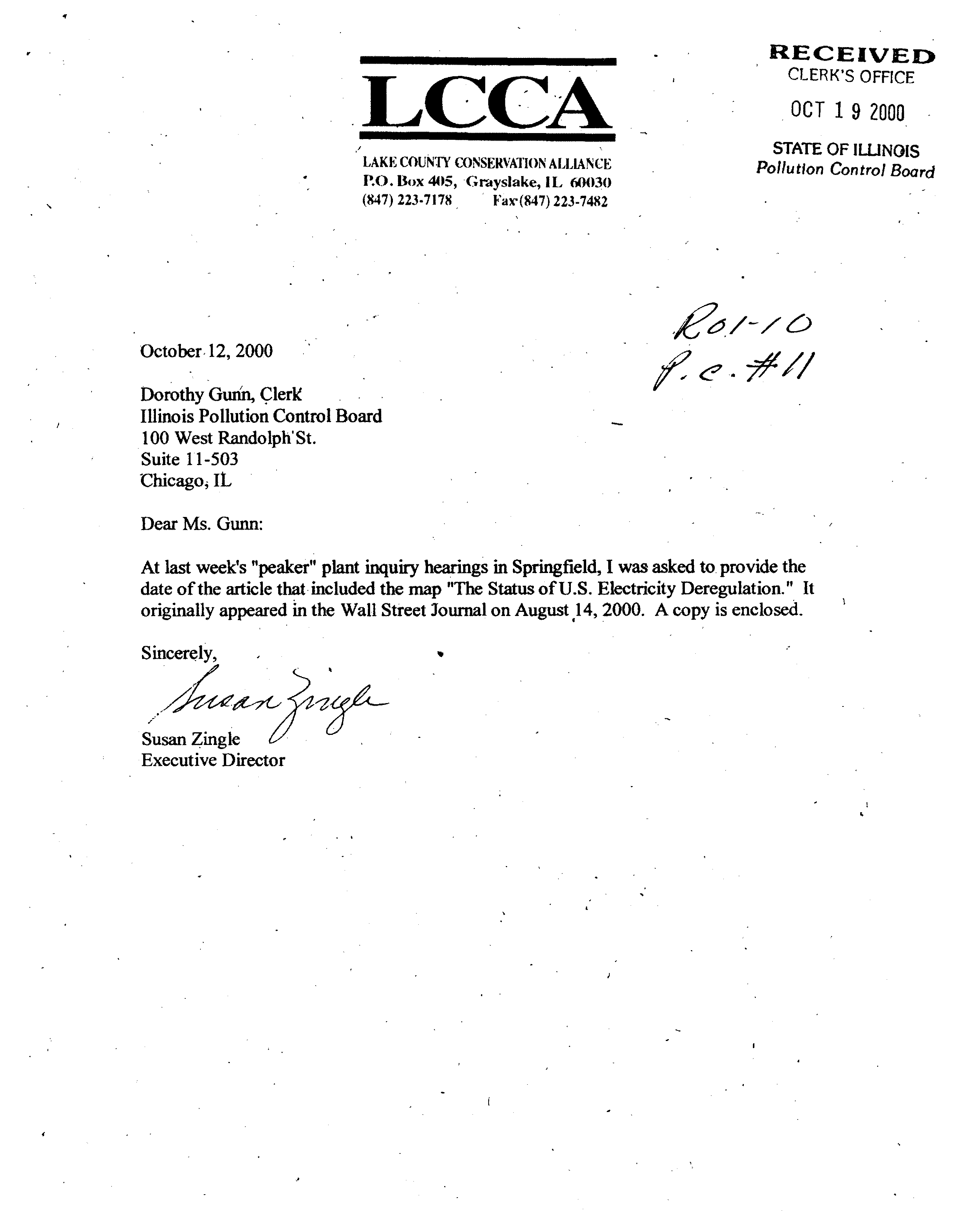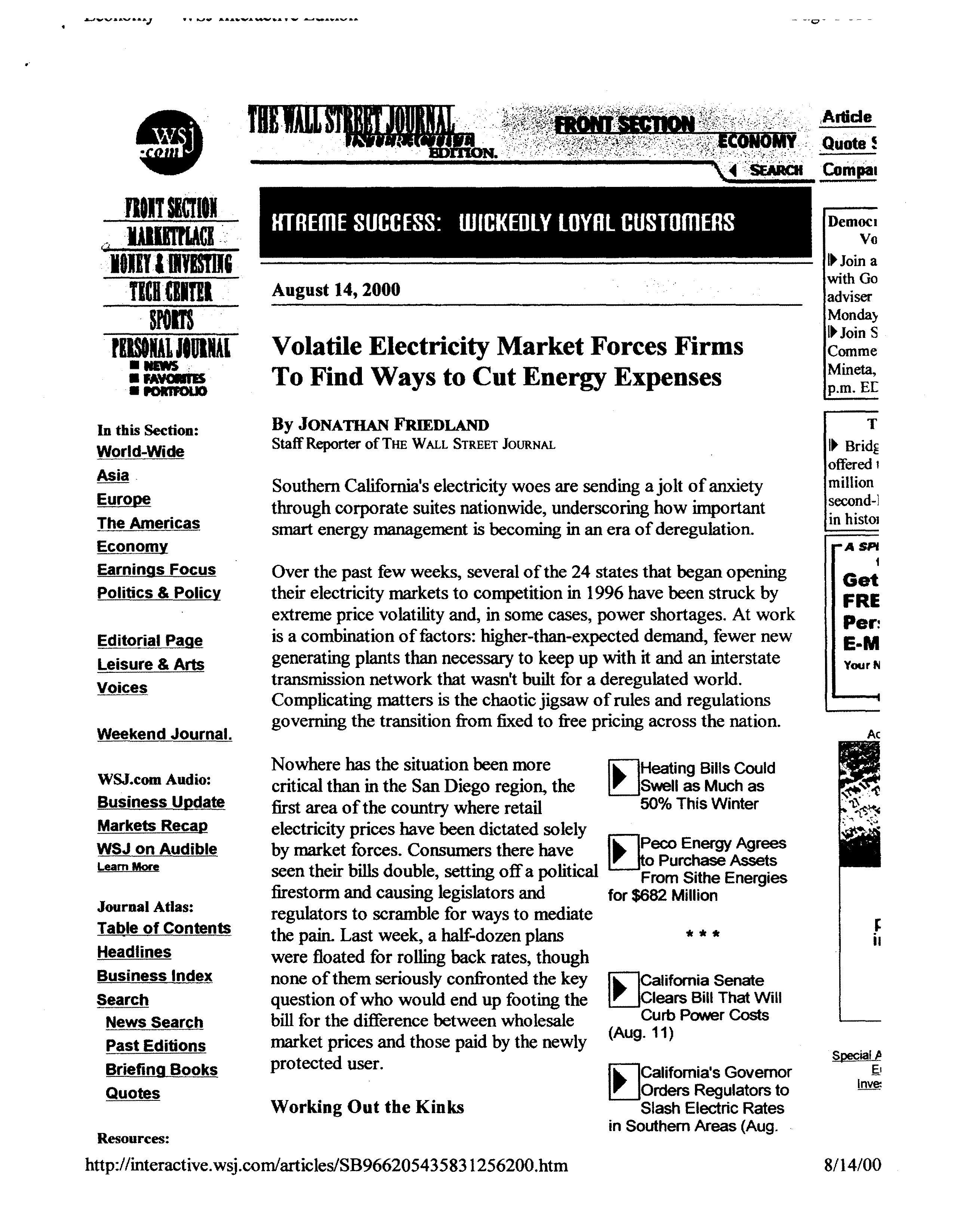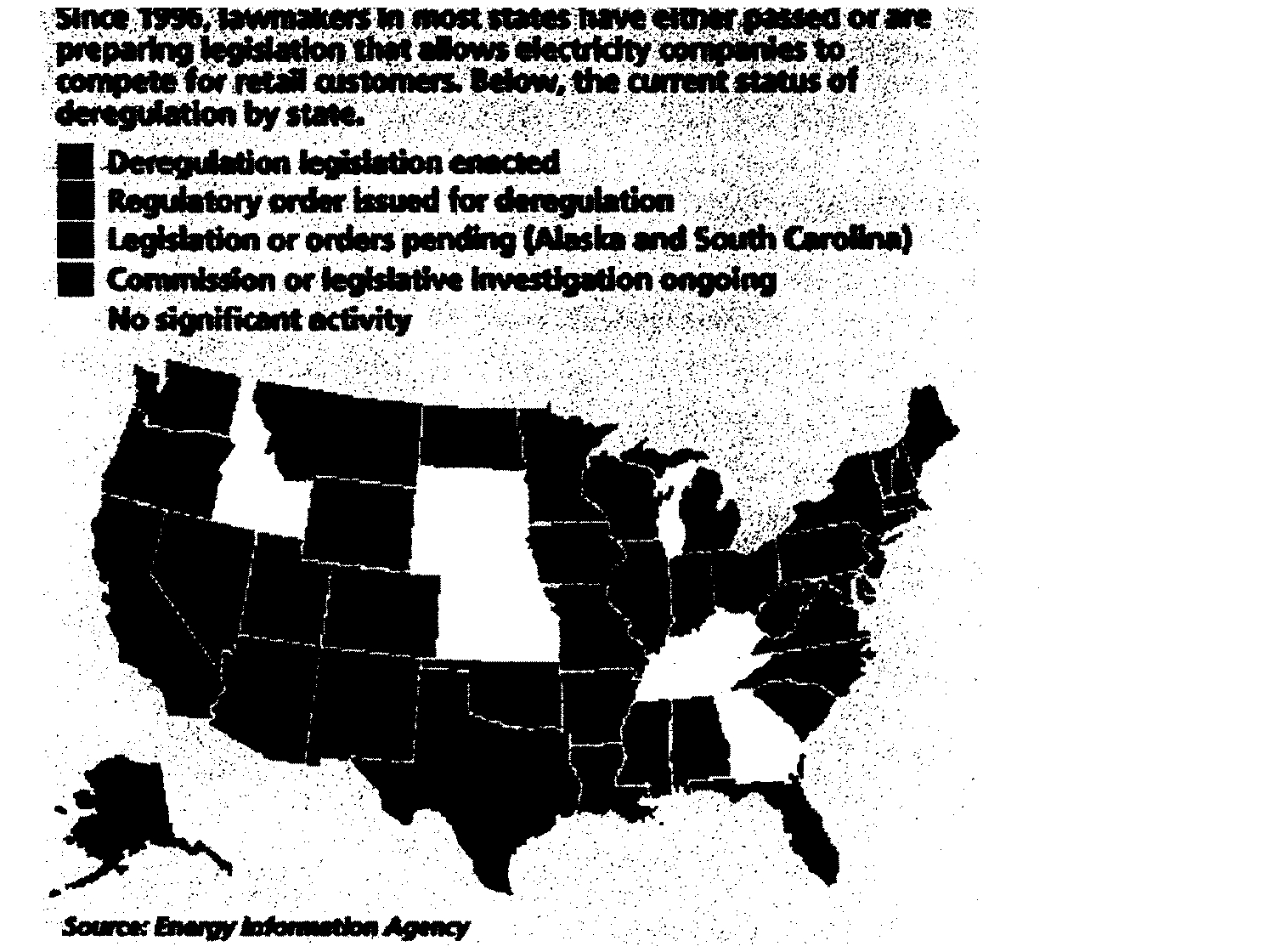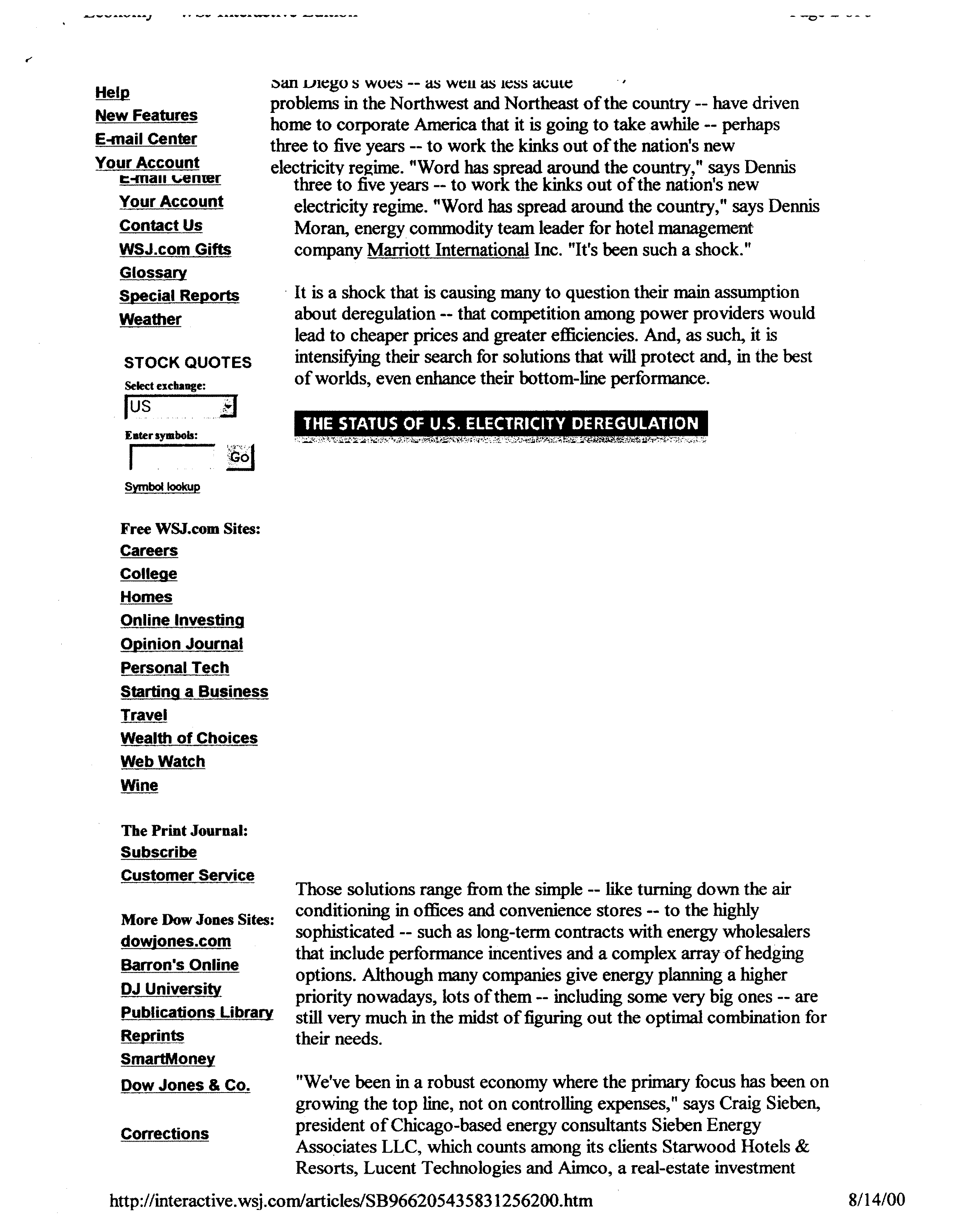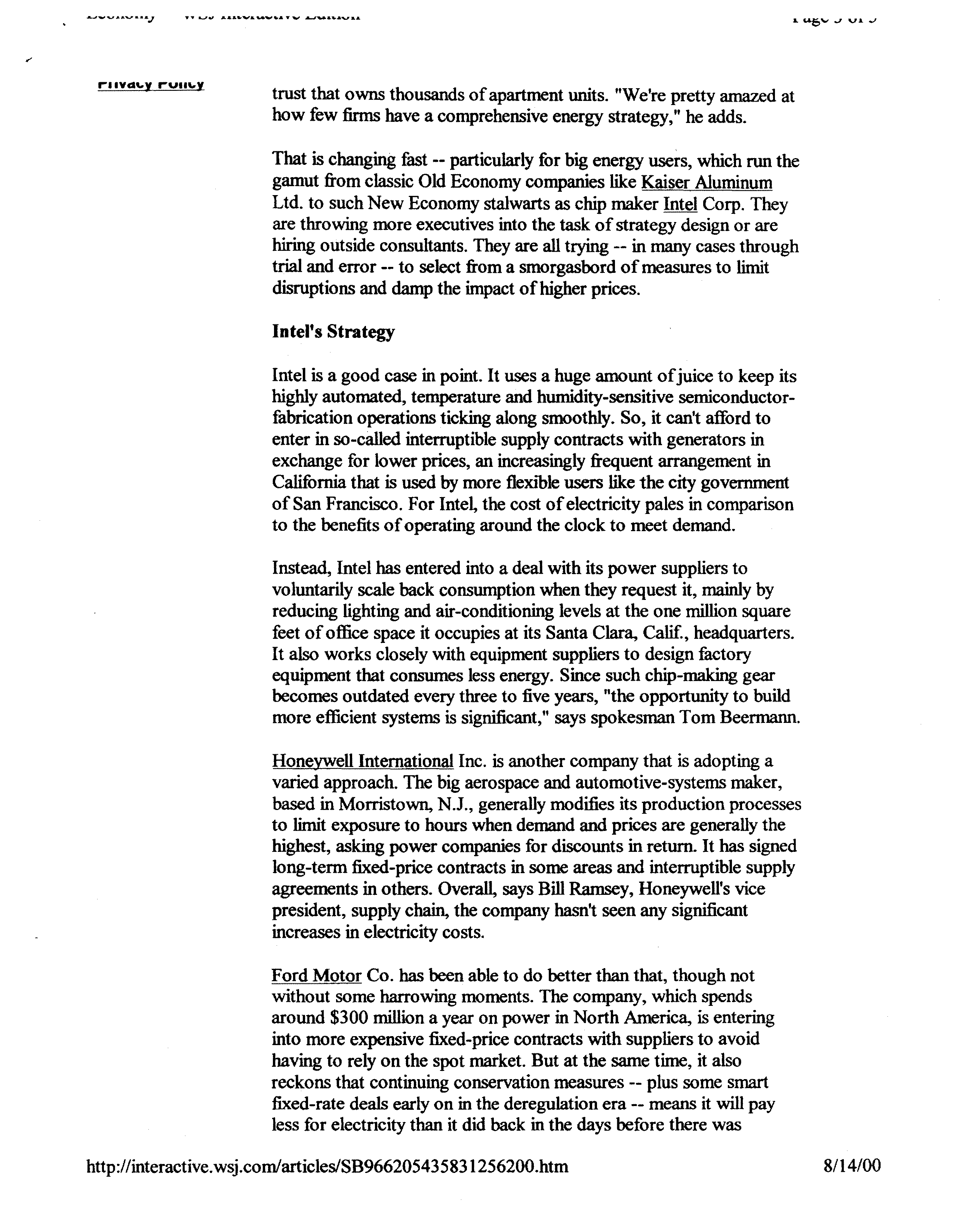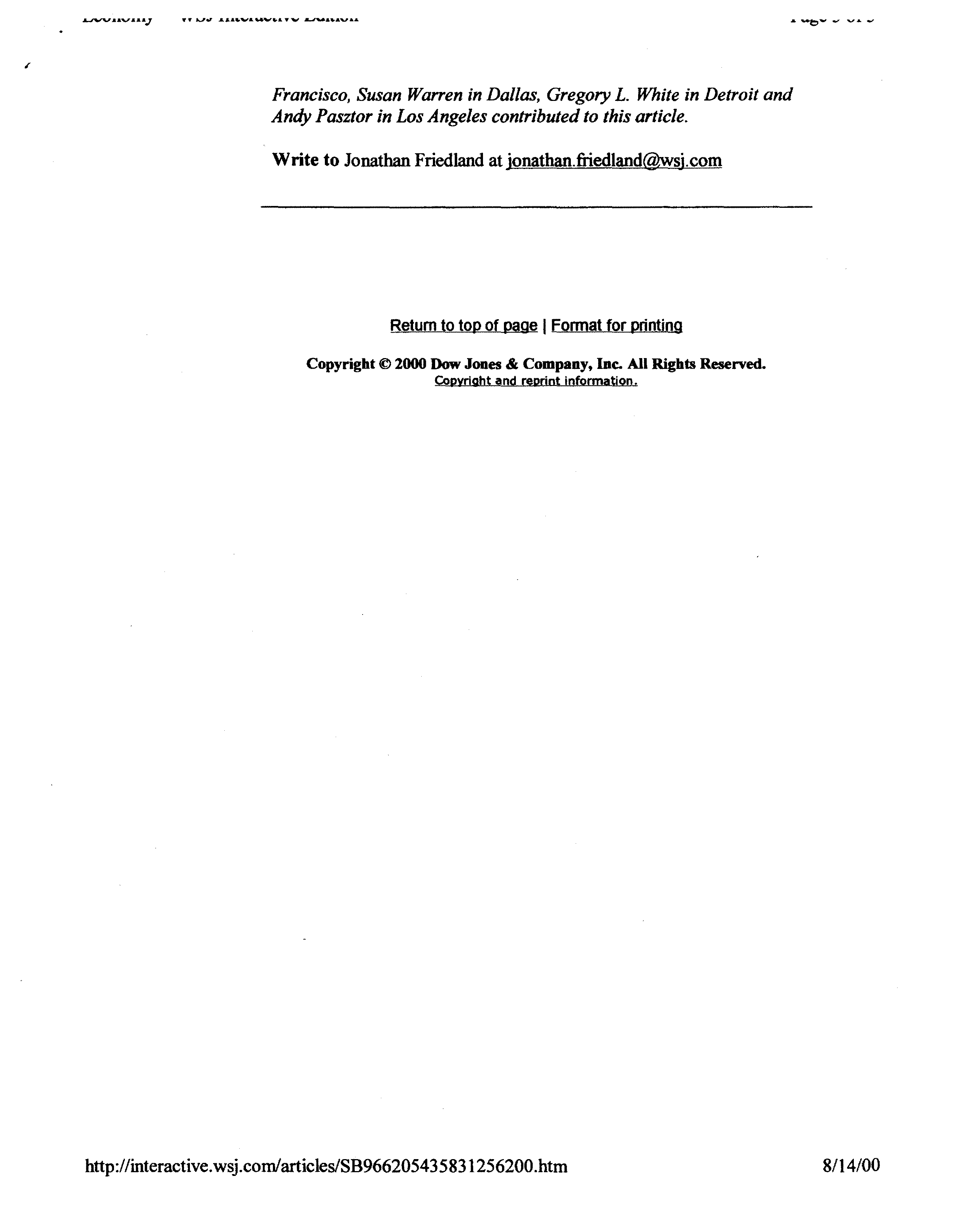October 12, 2000
Dorothy Gunn,
clerk
Illinois Pollution Control
Board
100 West
Randolph’
St.
Suite 11-503
Chicago,
IL
Dear Ms.
Gwm:
RECEIVED
CLERK’S OFF!CE
OCT19
2000
STATE
OF IWNOIS
Pollution Control Board
At
last
week’s
“peaker”
plant
inquiry
hearings in Springfield, I
was asked
to. provide the
date ofthe article
that included the map
“The
Status
ofU.S. Electricity Deregulation.” It
originally appeared in the Wall Street
Journal
on August 14, 2000. A copy is enclosed.
Sincerely,
7~1ff1(~
Susan Zingle
Executive Director
LCCA
LAKE COUNTY CO~SEKVA1iONALLIANCE
P~O.Box
405,
Gr4yslake, IL 6003()
(847)
223.7178
Fa,c(847) 223.7482
huT SECTLO~
~
lUll!
&IIYESTIJG
TEll
IIT!t
S?OtTS
LEISONAIJIUINA~
U
VIEWS
U
FAVC~V~
• PO*TFOUO
In
this Section:
World-Wide
Asia
Eur~pe
The Americas
F!c~n~rnY
Earrings Fpcu~
Politics & Policy
Editojj~iP~g~
Leisure &
Arts
Voices
Weekend Journal.
WSJ.coiu Audio:
Business ~P4at~
Markets Recap
WSJ on Audible
LearnM~e
Journal Atlas:
Table of
Contents
Headlines
Business Index
Search
News_Search
Past Editions
Briefing Bo~!ç~
Quotes
Resources:
~~~ROHOMY
Quote!
~4
SEAROI
Compat
KTREIIIE
SUCCESS: W~CKEIILY
UIYRL CUSilImERS
August 14,2000
Democi
Vu
lP~Joina
with Go
adviser
Monda~
9’Join S
Comme
Mineta,
p.m. EU
T
l~Brid~
offered
I
million
second-)
in histoi
A SPI
Get
FRE
Per:
E-M
Your N
—1
II
~c~LP
E
Invo
Back to top
Volatile Electricity Market Forces Firms
To Find Ways to Cut Energy Expenses
By
JONATHAN FRIEDLAIlI)
Staff Reporter
of
THE WALL STREET
JOURNAL
Southern California’s electricity woes are sending a jolt ofanxiety
through corporate suites nationwide, underscoring how important
smart energy management is becoming in an era of deregulation.
Over the past few weeks, several ofthe 24 states that began opening
their electricity markets to competition in 1996 have been struck by
extreme price volatility and, in some cases, power shortages. At work
is a combination offactors: higher-than-expected demand, fewer new
generating plants than necessary to keep up with it and an interstate
transmission network that wasn’t built for a deregulated world.
Complicating matters is the chaotic jigsaw ofrules and regulations
governing the transition from fixed to free pricing across the nation.
Nowhere has the situation been more
Heating Bills Could
critical than in the San Diego region, the
Swell as Much as
first area ofthe country where retail
50 Thts Winter
electricity prices have been dictated solely
by market forces. Consumers therehave
(~Peco Ener~iAgrees
I_Jo Purchase
Assets
seen their bills double, setting offa pohtical
From Sithe Energies
firestorm and causing legislators and
for $682 Million
regulators to scramble for ways to mediate
the pain. Last week, a half dozen plans
* * *
were floated for rolling back rates, though
none of them seriously confronted the key ~~California Senate
question ofwho would end up footing the L!~.JClearSBill That
Will
bill forthe difference between wholesale
Curb Power Costs
market prices and those paid by the newly ~9.
11)
protecteduser.
1~T1Califomia’sGovernor
E!JOrders Regulatorsto
Working Out the
Kinks
Slash Electric Rates
in Southern
Areas (Aug.
http://interactive.wsj.com/articles/SB96620543583 1256200.htm
8/14/00
New Features
E-mail
Center
Your Account
t-mait
i,enier
Your Account
Contact Us
WSJ.com Gifts
Glossary
Special Reports
Weather
STOCK QUOTES
Select
exchange:
lus
Entersymbols:
Symbol
lockup
Free WSJ.com
Sites:
Careers
College
Homes
Online Investing
Opinion Journal
Personal Tech
Starting
a Business
Travel
Wealth of Choices
Web Watch
Wine
The
Print
Journal:
Subscribe
Customer
Service
More
Dow Jones Sites:
dowjones.com
Barron’s
Online
DJ
University
Publications Library
Reprints
~ne
Dow Jones & Co.
Corrections
~anuiego
s woes
--
as weu
as
iess acute
problems in the Northwest and Northeast
ofthe country
--
have driven
home to
corporate America that
it is
going
to
take awhile
--
perhaps
three
to five
years
--
to work the
kinks
out ofthe nation’s new
electricity regime. ‘Word has spread around
the
country,” says Dennis
three
to five
years
--
to work the
kinks
out ofthe
nation~s
new
electricity regime,
“Word
has spread around
the
country,” says Dennis
Moran, energy commodity team leader
for hotel
management
companyMarriott
International Inc. “It’s
been
such
a
shock.”
It
is a
shock that is
causing many
to question
their main assumption
about
deregulation
--
that
competition among power providers would
lead
to
cheaper prices
and
greater efficiencies. And, as such, it is
intensil~jingtheir search
for
solutions that will protect and, in
the best
ofworlds, even
enhance their bottom-line performance.
US OF U .S.
EL.
CTRIC ITV DE
REGUL~J
Those solutions range
from the
simple
--
like turning down the air
conditioning in
offices and convenience stores
--
to
the highly
sophisticated
--
such as
long-term
contracts with energy wholesalers
that include performance
incentives and a complex
array
~f
hedging
options.
Although many companies
give energy
planning
a higher
priority nowadays,
lots ofthem
--
including some very
big ones
--
are
still very
much in the
midst
of
figuring
out the
optimal combination for
their needs.
“We’ve been in a robust economy where the
primary focus has been
on
growing
the top
line,
not on controlling
expenses,” says
Craig
Sieben,
president of
Chicago-based energy consultants
Sieben Energy
Associates
LLC, which counts among its clients Starwood Hotels &
Resorts, Lucent Technologies and Aimco, a real-estate investment
http://interactive.wsj.com/articles/SB966205435831256200.htm
8/14/00
..~
‘.JL
..‘
rlIvds.y
ruj~~y
trust that owns thousands
of
apartment units. “We’re pretty amazed
at
how
few
firms have a comprehensive energy strategy,”
he adds.
That is changing fast
--
particularly
for
big
energy users, which run the
gamut
from
classic
Old
Economy companies like Kaiser Aluminum
Ltd. to such New Economy
stalwarts as chip maker Ii~iCorp. They
are throwing more
executives into the
task
ofstrategy design or
are
hiring
outside
consultants.
They
are all trying
--
in
many
cases through
trial and error
--
to
select
from a
smorgasbord
of
measures
to
limit
disruptions and damp
the
impact
of
higher prices.
Inte”s
Strategy
Intel is a good
case in point.
It
uses
a huge
amount
ofjuice to keep its
highly automated, temperature and humidity-sensitive semiconductor-
fabrication operations ticking along smoothly.
So, it
can’t
afford to
enter in
so-called interruptible
supply contracts with generators in
exchange for lower prices, an increasingly frequent arrangement in
Cali!brnia that is used
by more
flexible users like
the
city government
of
San Francisco.
For Intel, the
cost
ofelectricity pales in
comparison
to the benefits ofoperating around the clock to meet
demand.
Instead,
Intel
has
entered
into a
deal with its power suppliers to
voluntarily scale back consumption when
they request it,
mainly by
reducing
lighting
and
air-conditioning levels at the one million
square
feet ofoffice space it occupies at its Santa
Clara, Calif. headquarters.
It
also
works
closely
with equipment
suppliers
to design
factory
equipment that
consumes less energy.
Since
such
chip-making gear
becomes outdated every three
to five
years,
“the
opportunity
to build
more efficient
systems
is significant,” says spokesman Tom
Beermann.
Honeywell International Inc. is another companythat is adopting a
varied
approach. The big aerospace and automotive-systems
maker,
based in Morristown,
N.J., generally
modifies
its production processes
to
limit exposure
to hours when
demand and prices
are generally the
highest,
asking
power
companies
for
discounts in return.
It has
signed
long-term
fixed-price contracts
in some areas and
interruptible supply
agreements
in others.
Overall,
says
Bill Ramsey,
Honeywell’s vice
president, supply
chain,
the
company hasn’t seen any significant
increases
in electricity costs.
Ford Motor Co. has
been
able to do better
than
that, though not
without some
harrowing
moments. The company, which spends
around
$300
million
a year on power in North
America,
is entering
into more
expensive fixed-price
contracts with suppliers to avoid
having to rely on the
spot
market. But at the
same time,
it also
reckons
that continuing
conservation
measures
--
plus some
smart
fixed-rate deals early on in the deregulation era
--
means it
will
pay
less for electricity
than
it did back in the days before there was
http://interactive.wsj.com/articles/SB966205435831256200.htm
8/14/00
L41~#t1*1SSSJ
- -
TV
U.’
aA~,s*a,b.,
—,
competition.
Pete
Mehra,
Ford’s energy chief,
said
the auto maker has
learned some
hard
lessons.
Last
summer, it
was
forced to briefly
pay
one ofits
suppliers rates ofas much as $9,000
per
megawatt hour to keep the
lights on at its Kentucky truck plant, whichmakes the
company’s
hugely profitable big pickups and
sports-utility
vehicles. Accustomed
to paying around $40 per megawatt hour to power the plant,
“that
one
week killed us,” Mr. Mehra says.
Enron’s Business Booms
While companies like
Ford enter into long-term contracts only
reluctantly
--
a
bad
decision could put it at cost disadvantage to its
competitors
--
service companies
generally
have less qualms. Energy
trading
company
Enron Corp., which signed contracts to supply $3.8
billion in energy and energy
services
to customers last quarter alone, is
doing a bustling
business offering
security
in times of
uncertainty.
Depending on the client’s appetite for risk, it offers packages that mix
fixed and
indexed rates much as a mortgage does.
And
it provides
incentives to those firms
that
allow it to replace their energy
infrastructure
over
time
--
which, in turn,
gives Enron a better
sense
of
what the client
will
be spending. Among the companies
that
have
signed up
with
the Houston-based company
are
Prudential
Insurance
Co. of
America,
Chase
Manhattan
Corp. and ~jrn~i~Pro
e~Qr~p,
one of
the
largest U.S. REITs.
Companies for
whom
electricity is a make-or-break operating cost
have less
flexibility
--
and are the
ones that have been
hit
worst by
current market conditions. Copper company
~~p~j~!od
e Corp.,
Phoenix, has
boosted
in-house generation to reduce its reliance on
commercial suppliers
and
is juggling its production schedules to shut
down equipment at times when the cost ofpower outstrips the value
of the ore
being mined and
smelted.
Rod Prokop, investor-relations director, says higher energy costs
coupled with interruptions at its
operations in Arizona and
New
Mexico, both deregulated markets, shaved around $5 million off
Phelps’s second-quarter earnings, leading to a
$37.5
million
loss in the
period. Mr. Prokop adds
that
Phelps will likely feel the impact of
volatile markets for
the
foreseeable
future
--
no
matter
what it does.
While
the changed energy scenario has
spooked
executives, it
hasn’t
generally turned them
against
deregulation. If
anything,
they see
current problems resulting from the
fact that
legislators have been too
timid in
unleashing
market forces.
--
Staff
writers
Karen Jacobs in New York, David Hamilton in San
http://interactive.wsj.com/articles/SB96620543583l256200.htm
8/14/00
SJFLflfl~A*AJ
TV S.F.’
saa...aa~n.s
V W
Francisco, Susan
Warren
in Dallas, Gregory L. White in Detroit and
Andy Fasztor in Los Angeles contributed to this article.
Write to
Jonathan Friedland atjonathan.ffiedland(ä~wsj.com
Return to top of
paae I
Format for
painting
Copyright ©
2000
Dow
Jones &
Company,
Inc. All
Rights Reserved.
Copyright
and
reonnt
informatiot~.
http://interactive.wsj.com/articles/SB966205435831256200.htm
8/14/00
